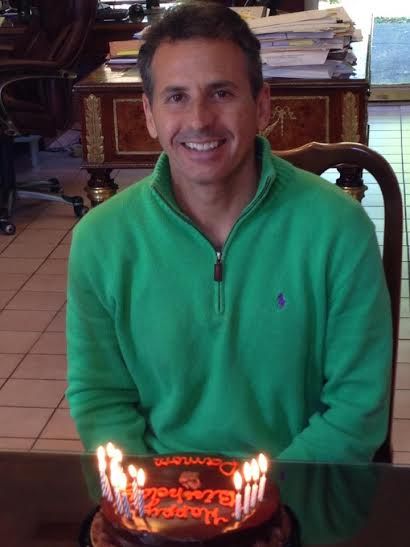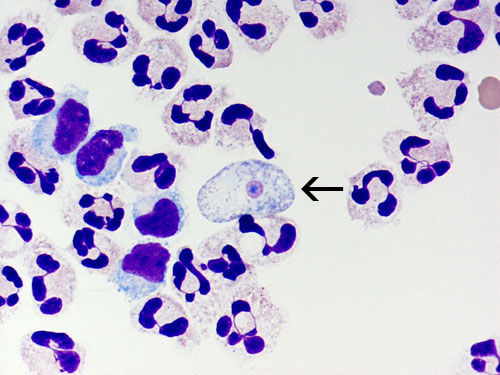
Player of the Week: Nykalys Pasache
August 20, 2015
Houma politico on Ashley Madison list
August 22, 2015In a year when people in the Bayou Region have had to deal with reports of flesh-eating bacteria in the seas and viral meningitis at a day camp, news of a brain-eating amoeba in the Terrebonne Parish water supply has made for lots of discomfort and questions.
Parents put off bathing children, pool parties were at risk of cancellation and some local residents got messages from friends in other parts of the country expressing concern after learning of the discovery from national news and Internet outlets.
Officials maintain that there is no need for alarm, and say that discovery of an amoeba that poses danger if ingested deep into nasal passages is the result of new surveillance systems, not any increased organism presence.
“The water is safe to drink,” said Mike Sorbert, manager of the Terrebonne Water District, which captures, treats and distributes the water that runs through 1,000 miles of conduit and pipe to homes, businesses and hydrants throughout the parish. “I am in the business of making the best water possible, good, potable drinking water.”
Discovery of the Naegleria fowleri amoeba in water from a fire hydrant feed in the remote bayou community of Pointe-aux-Chenes, has been reborn within the 24-hour national news cycle, where it has gotten significant play.
The CBS network trumpeted, “Brain-eating amoeba found in Louisiana small town water.” The Web-based service Weather Underground carried the message from coast-to-coast and beyond.
State and local officials who work with water safety on a daily basis, however, say the alarm and the notoriety actually results from a curious paradox, which is rooted in good news.
The ability of health officials to discover and therefore deal with Naegleria fowleri and other pathogens, they say, is more precise than ever. That means news of organisms always around, but not the subject of intensive detection protocol in the past, is and will be surfacing.
Louisiana’s protocol for detecting the NF amoeba, state health officials maintain, is unequalled.
“This is something not done elsewhere in the country,” said Dr. Jimmy Guidry, chief health officer for the Louisiana Department of Health and Hospitals. “The CDC has developed a new test during which we filter for an hour and now we are finding the amoebas. We are surveying systems around the state where we have seen they have a low chlorine level in the system.”
The tests employed, he explained, are somewhat new and performed nationally. What Louisiana does differently is conduct the stepped-up surveillance on a routine basis.
The vigilance was born of tragedy.
In 2011, the state reported two deaths related to the amoeba. But how they contracted illness was initially something of a mystery. The victims – a 28-year-old man and a 51-year-old woman – had not been engaged in activities that would have made contact with the amoeba likely, such as swimming in fresh water. The victims’ home plumbing systems, however, were found to harbor the amoeba. The route for tragedy came through their noses, due to the use of neti pots to clear their sinuses with tap water that contained the amoeba.
The NF amoeba is clothed in a contradiction of sorts. Chances that it will reach the area in the upper sinuses that is a pathway to the brain are low, making the risk somewhat negligible.
“It’s not that easy to get the infection even when exposed,” Guidry said.
If the amoeba finds its target, however, the results are sadly predictable.
“The diagnosis is made at death when the amoeba is growing in the brain,” Guidry reported. The U.S. Centers for Disease Control says that once contact with brain tissue is made death is almost certain.
The problems Louisiana communities have experienced, Guidry and other experts say, are partially due to the chemistry of water, disinfectants and heat.
The Terrebonne Parish water system, like many others, uses a chemical called chloramine, best described as an ammonia-chlorine hybrid, to keep water safe once it exists the treatment system, where it has already been treated with chlorine.
The U.S. Environmental Protection Administration has advised water systems to avoid use of pure chlorine, because certain pathogens can be resistant to the chemical.
During the course of the year, technicians test for pathogens near the Schriever plant, and the tests generally come up zero.
But they are also testing at the farthest flung locations in the water system.
Sorbert and other officials say that if the outlying water pipes have no problems, then the system in general is in good shape.
Testing the extremes is important, Sorbert said, because many of those areas underutilize water. That means water sits in the pipes for a longer period of time, giving disinfectant agents a chance to break down, and letting heat do its work.
On Aug. 4, Sorbert received an e-mail from the Louisiana Department of Health and Hospitals, letting him know that the next day technicians would arrive in Terrebonne Parish to do a sample sweep at end-of-the-line areas of the system.
Such sweeps, Dr. Guidry said, are part of the state’s new detection system and Terrebonne, like other jurisdictions, is and has been cooperative.
“We have to take the technicians to the places they say,” Sorbert explained. “They don’t know Pointe-aux-Chenes or Cocodrie, so we take them there.”
Samples are taken using special filters at the various water sources and on Aug. 5 technicians and Sorbert’s staff stayed busy.
“Nobody stopped for lunch,” he said.
That evening, the technicians returned to Baton Rouge and their bagged, sealed samples were brought to a lab, where standard protocols were performed, including labeling, separating and centrifuging.
Water samples were placed in petri dishes where cultures were grown for a required seven days, officials confirmed.
After that tests were performed, and the presence of the amoeba was suspected in the Pointe-aux-Chenes sample. Further tests were required and, at some point on Aug. 17, the presence of Naegleria fowleri was confirmed.
“They told us on the 17th,” Sorbert said. “We would like to know sooner. But this is the time that is required for it to be done. It can’t be done in less time.”
It is likely that Naegleria fowleri might not have shown up in a potable water sample taken years ago, because it could not have grown in water disinfected with pure chlorine; if it did then the testing methodology would not have existed and, therefore, detection would not have occurred.
Until recently only a specialized CDC test could have detected the amoeba and the technology was rarely used.
The use of chloramine came about as a way of reducing byproducts from pure chlorine use that were regulated by the federal government.
The typical purpose of chloramine is to provide longer-lasting water treatment as the water moves through pipes to consumers. This type of disinfection is known as secondary disinfection. Chloramines have been used by water utilities for almost 90 years, and their use is closely regulated, according to the EPA. Water that contains chloramines and meets EPA regulatory standards is safe to use for drinking, cooking, bathing and other household purposes.
But as the chloramine disinfects, the chlorine molecules present in it degrade as part of that process. When that happens, nitrogen, which helps mostly harmless organisms to grow since it is a building block of life, remains.
Some of those organisms become a food source for other organisms, like the one-celled Naegleria fowleri, which thrives in heat. That, Guidry, Sorbert and other officials believe, is likely how the amoeba ended up in the Terrebonne system, in a pipe in a far-flung area of the parish.
It is why Sorbert now will make a change to his disinfectant recipe, which will be all chlorine. Technically this is called a “chlorine burn.”
It amounts to the treatment the water plant used prior to the use of chloramine, now considered the best practice. The switch requires DHH approval, as is required anytime the treatment process is changed.
Interactions of chlorine and ammonia, Sorbert said, must be delicately balanced. It is now likely that when hotter weather approaches, the pure chlorine levels in Terrebonne water will be higher, and then eased when temperatures drop.
“We are always learning better ways to treat water,” Sorbert said. “This year’s water, I maintain, is better than last year’s water. Next year’s water will be better than the water this year.”
Guidry agrees that disinfectant mixes can be a challenge for water suppliers, which is why his staff is working closely and proactively with people who run systems like the one in Terrebonne.
“There is a challenge for water systems and maintaining chlorine levels, especially in a system like Schriever, which has a lot of pipe,” he said.
The switch to chlorine, Sorbert said, might be noticeable briefly in drinking water. But it is as safe as the chloramine, he said.
“It’s just as safe today as it was ten years ago,” Sorbert said.
Other water system and health officials say they are confident that the amoeba issue was handled correctly, and that continued practice monitoring will keep water supplies safe.
“Our requirements parish-wide are even stronger than what the state standards are,” said Water District chairman Al Badeaux Jr. “When the state required more testing to be done throughout Louisiana, our standard was already higher.”
The Terrebonne amoeba has also had an effect on a neighboring water system.
The Lafourche Parish Water District purchases water from Terrebonne for Marydale, Grand Bois, and Romero Street in Bayou Blue.
“Tap water in Terrebonne Parish as well as the Marydale Subdivision, Grand Bois, and Romero Subdivision is safe for residents to drink,” a statement issued by the Lafourche Parish government says, noting that residents must avoid getting water in their noses.
DHH has this year tested 21 water systems for the amoeba. Positive results, in addition to Terrebonne, were logged in St. Bernard and Ascension parishes.
Water officials noted that the use of neti pots or other means of getting water into sinuses for cleansing has never involved recommendations of pure tap water.
Distilled water is and has been the recommended substance for use, health and water officials said.
The following recommendations were given for people to follow, so that they can avoid problems related to water in light of the recent developments.
• DO NOT allow water to go up your nose or sniff water into your nose when bathing, showering, washing your face, or swimming in small hard plastic/blow-up pools.
• DO NOT jump into or put your head under bathing water (bathtubs, small hard plastic/blow-up pools); walk or lower yourself in.
• DO NOT allow children to play unsupervised with hoses or sprinklers, as they may accidentally squirt water up their nose. Avoid slip-n-slides or other activities where it is difficult to prevent water going up the nose.
• DO run bath and shower taps and hoses for five minutes before use to flush out the pipes. This is most important the first time you use the tap after the water utility raises the disinfectant level.
• DO keep small hard plastic/blow-up pools clean by emptying, scrubbing and allowing them to dry after each use.
• DO use only boiled and cooled, distilled or sterile water for making sinus rinse solutions for neti pots or performing ritual ablutions.
• DO keep your swimming pool adequately disinfected before and during use. Adequate disinfection means:
– Pools: free chlorine at 1 to 3 parts per million (ppm) and pH 7.2 to 7.8, and
– Hot tubs/spas: free chlorine 2 to 4 parts per million (ppm) or free bromine 4 to 6 ppm and pH 7.2 to 7.8.











